Towards Sustainable Heritage Tourism: A Space Syntax-Based Analysis Method to Improve Tourists’ Spatial Cognition in Chinese Historic Districts
Abstract
1. Introduction
2. Overview of Space Syntax
3. Proposed Method
3.1. Extraction of Spatial Morphology Information
3.2. Analysis of Tourists’ Spatial Cognition
4. Case Studies: Nanyang and Wuzhen
4.1. Overview of Nanyang
4.2. Interpreting the Spatial Syntax Analysis of Nanyang
4.3. Comparing the Results of Nanyang with Wuzhen
4.4. Suggestions for Nanyang and Future Research
5. Conclusions
Author Contributions
Funding
Acknowledgments
Conflicts of Interest
References
- Turner, A. From axial to road-centre lines: A new representation for space syntax and a new model of route choice for transport network analysis. Environ. Plan. B Plan. Design 2007, 34, 539–555. [Google Scholar] [CrossRef]
- Jiang, B. A Space Syntax Approach to Spatial Cognition in Urban Environments. In Position paper for NSF-funded research workshop Cognitive Models of Dynamic Phenomena and Their Representations; University of Pitts-burgh: Pittsburgh, PA, USA, 1998. [Google Scholar]
- Turner, A.; Friedrich, E.; Varoudis, T.; Sailer, C.; Koutsolampros, P. depthmapX, 0.6.0; depthmapX development team: University College London, 2017. Available online: https://github.com/SpaceGroupUCL/depthmapX/ (accessed on 12 July 2019).
- Mishra, S.A.; Pandit, R.K. Space syntax spproach for analyzing crime preventive urban design: Concept review. J. Adv. Res. Constr. Urban Archit. 2016, 1, 30–35. [Google Scholar]
- Heyman, A.; Manum, B. Distance, accessibilities and attractiveness; urban form correlates of willingness to pay for dwellings examined by space syntax based measurements in GIS. J. Space Syntax. 2016, 6, 213–224. [Google Scholar]
- Li, X.; Lv, Z.; Zheng, Z.; Zhong, C.; Hijazi, I.H.; Cheng, S. Assessment of lively street network based on geographic information system and space syntax. Multimed. Tools Appl. 2017, 76, 17801–17819. [Google Scholar] [CrossRef]
- Shahbazi, M.; Bemanian, M.R.; Lotfi, A. A comparative analysis of spatial configuration in designing residential houses using space dyntax method (Case Studies: Houses of isfahan and modern architecture styles). Int. J. Appl. Arts Stud. (IJAPAS) 2018, 3. Available online: http://www.ijapas.com/index.php/ijapas/article/view/190 (accessed on 10 November 2019).
- Gifford, R. Environmental Psychology: Principles and Practice, 5th ed.; Optimal books: Colville, WA, USA, 2014. [Google Scholar]
- Duan, J.; Hillier, B.; Shao, S.; Dai, X. Space Syntax and Urban Planning; Southeast University: Nanjing, China, 2007; pp. 38–46. [Google Scholar]
- Hillier, B. Space is the Machine: A Configurational Theory of Architecture; Cambridge University Press: Cambridge, UK, 1996. [Google Scholar]
- Duan, J.; Hillier, B. Urban. Space 3: Space Syntax and Urban. Planning; Southeast University Press: Nanjing, China, 2007. [Google Scholar]
- Turner, A.; Penn, A.; Hillier, B. An algorithmic definition of the axial map. Environ. Plan. B Plan. Des. 2005, 32, 425–444. [Google Scholar] [CrossRef]
- Rahman, J.I.; Ismail, H.N.; Wai, C.L. Inquiry into Tourists’ Movement Flow Pattern in the Melaka World Heritage Site: A Space Syntactic Analysis; APSA Congress, Universiti Teknologi Malaysia: Johor, Malaysia, 2011. [Google Scholar]
- Turner, A.; Doxa, M.; O’sullivan, D.; Penn, A. From isovists to visibility graphs: A methodology for the analysis of architectural space. Environ. Plan. B Plan. Des. 2001, 28, 103–121. [Google Scholar] [CrossRef]
- Shokouhi, M. Legible Cities: The Role of Visual Clues and Pathway Configuration in Legibility of Cities. In Proceedings of the 4th International Space Syntax Symposium, London, UK, 17–19 June 2013. [Google Scholar]
- Tao, Y. Digital City and Space Syntax: A Digital Planning Approach. Planners 2012, 28, 24–29. [Google Scholar]
- Koohsari, M.J.; Sugiyama, T.; Mavoa, S.; Villanueva, K.; Badland, H.; Giles-Corti, B.; Owen, N. Street network measures and adults’ walking for transport: Application of space syntax. Health Place 2016, 38, 89–95. [Google Scholar] [CrossRef]
- Li, Y.; Xiao, L.; Ye, Y.; Xu, W.; Law, A. Understanding tourist space at a historic site through space syntax analysis: The case of Gulangyu, China. Tour. Manag. 2016, 52, 30–43. [Google Scholar] [CrossRef]
- Kubat, A.; Rab, S.; Guney, Y.I.; Ozer, O.; Kaya, S. Application of Space Syntax in Developings: A Regeneration Framework for Sharjah’s Heritage Area. In Proceedings of the 8th International Space Syntax Symposium, Santiago, Chile, 3–6 January 2012. [Google Scholar]
- Sheng, Q.; Zhou, C.; Karimi, K.; Lu, A.; Shao, M. The application of space syntax modeling in data-based urban desian: An example of Chaoyang square renewal in Jilin city. Landsc. Archit. Front. 2018, 6, 102–114. [Google Scholar] [CrossRef]
- Lynch, K. The Image of the City; MIT press: Cambridge, MA, USA, 1960; Volume 11. [Google Scholar]
- Montello, D.R. The Contribution of Space Syntax to a Comprehensive Theory of Environmental Psychology. In Proceedings of the 6th International Space Syntax Symposium, Istanbul, Turkey, 12–15 June 2007; Available online: http://www.spacesyntaxistanbul.itu.edu.tr/papers/invitedpapers/daniel_montello.pdf (accessed on 7 June 2019).
- Rollo, J.; Barker, S. Perceptions of Place-evaluating experiential qualities of streetscapes. In Proceedings of the SOAC 2013 6th State of Australian Cities Conference, Sydney, Australia, 26–29 November 2013; pp. 1–11. [Google Scholar]
- Hillier, B. Studying cities to learn about minds: Some possible implications of space syntax for spatial cognition. Environ. Plan. B Plan. Des. 2012, 39, 12–32. [Google Scholar] [CrossRef]
- Burgess, N. Spatial cognition and the brain. Ann. N. Y. Acad. Sci. 2008, 1124, 77–97. [Google Scholar] [CrossRef]
- Yearbook, C.S. Beijing: National Bureau of Statistics of China; China Statistics Press: Beijing, China, 2015. [Google Scholar]
- Sun, J. Construction of industrial heritage corridor in the Jiangnan section of Beijing-Hangzhou Grand Canal. World Cult. 2000, 9, 21–23. [Google Scholar]
- Cheung, S.W. Construction of the grand canal and improvement in transportation in late imperial china. Asian Soc. Sci. 2008, 4, 11–22. [Google Scholar] [CrossRef]
- Sun, B. Spatial development along Beijing-Hangzhou Grand Canal: A case study of Yangzhou section. Archit. Herit. China 2013, 10, 19–26. [Google Scholar]
- Li, J.; Duan, J. Multi-scale representation of urban spatial morphology based on GIS and spatial syntax. J. Cent. China Norm. Univ. Nat. Sci. 2004, 38, 383–387. [Google Scholar]
- Berghauser Pont, M.; Stavroulaki, G.; Marcus, L. Development of urban types based on network centrality, built density and their impact on pedestrian movement. Environ. Plan. B Urban Anal. City Sci. 2019, 46, 1549–1564. [Google Scholar] [CrossRef]
- Lin, C.-H.; Morais, D.B.; Kerstetter, D.L.; Hou, J.-S. Examining the role of cognitive and affective image in predicting choice across natural, developed, and theme-park destinations. J. Travel Res. 2007, 46, 183–194. [Google Scholar] [CrossRef]
- Usui, H. Statistical distribution of building lot depth: Theoretical and empirical investigation of downtown districts in Tokyo. Environ. Plan. B Urban. Anal. City Sci. 2019, 46, 1499–1516. [Google Scholar] [CrossRef]
- Noyman, A.; Doorley, R.; Xiong, Z.; Alonso, L.; Grignard, A.; Larson, K. Reversed urbanism: Inferring urban performance through behavioral patterns in temporal telecom data. Environ. Plan. B Urban Anal. City Sci. 2019, 46, 1480–1498. [Google Scholar] [CrossRef]
- Kaplan, S. Perception and landscape: conceptions and misconceptions. In Proceedings of the our National landscape: A Conference on Applied Techniques for Analysis and Management of the Visual Resource, Incline Village, NV, USA, 23–25 April 1979. [Google Scholar]
- Alazaizeh, M. Sustainable Heritage Tourism: A Tourist-Oriented Approach for Managing Petra Archaeological Park, Jordan. Ph.D. Thesis, School of Clemson University, Clemson, SC, USA, 2014. [Google Scholar]
- Jones, D. Evolution and significance of the regeneration reserve heritage landscape of Broken Hill: History, values and significance. Hist. Environ. 2016, 28, 40–57. [Google Scholar]
- Jones, D.; Beza, B.B. An Indigenous perspective on sustainability citizenship. In Sustainability Citizenship and Cities: Theory and Practice; Horne, R., Fien, J., Beza, B., Nelson, A., Eds.; Routledge: Abingdon, UK, 2016; pp. 150–162. [Google Scholar]
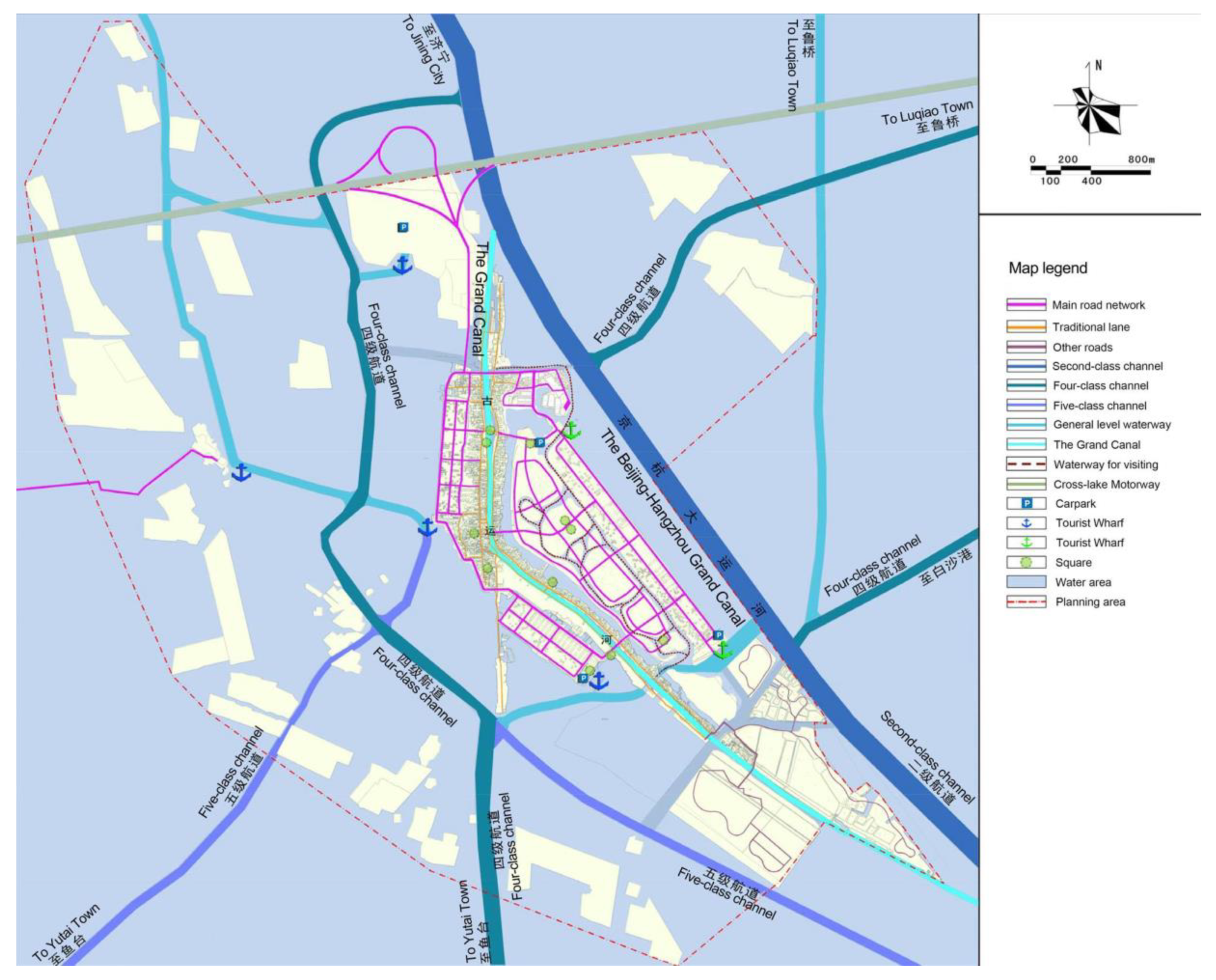
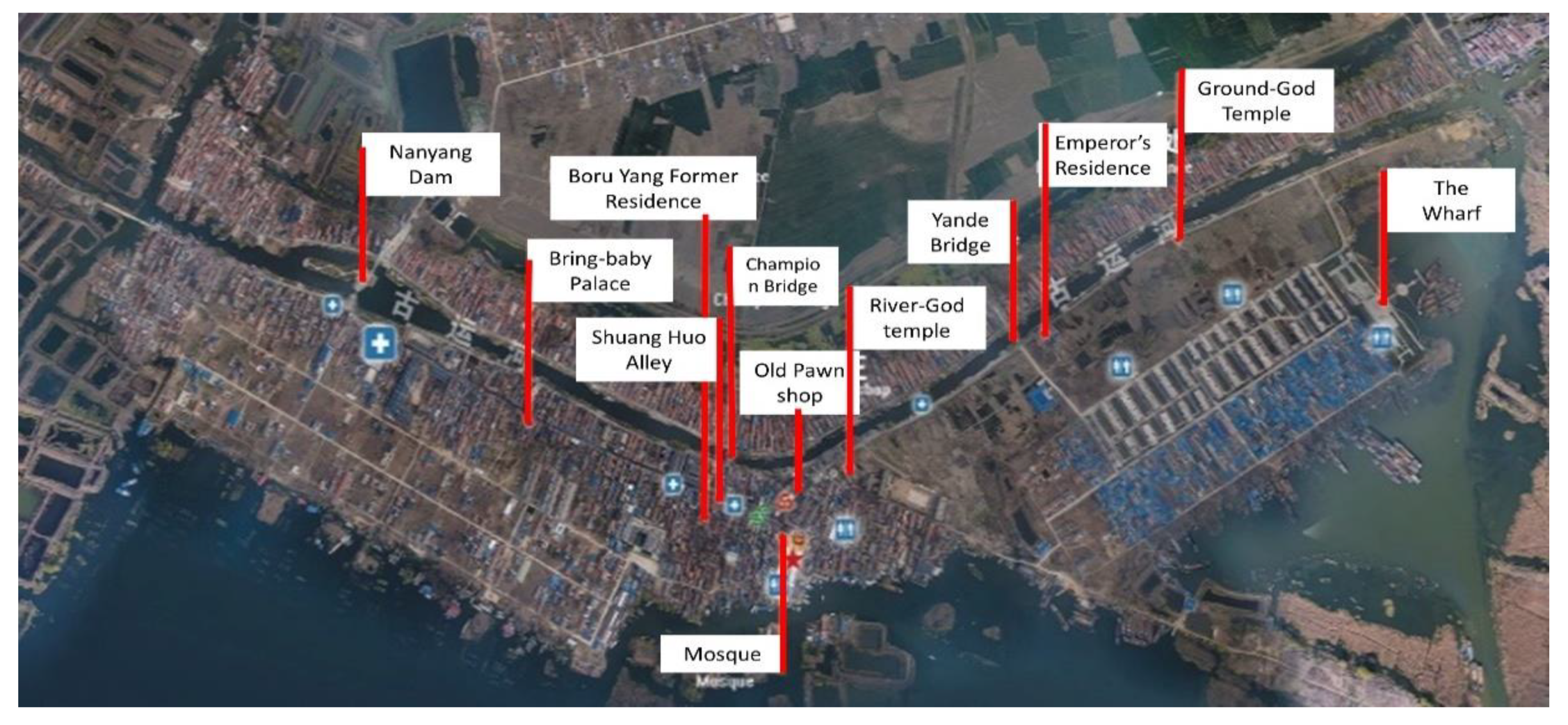
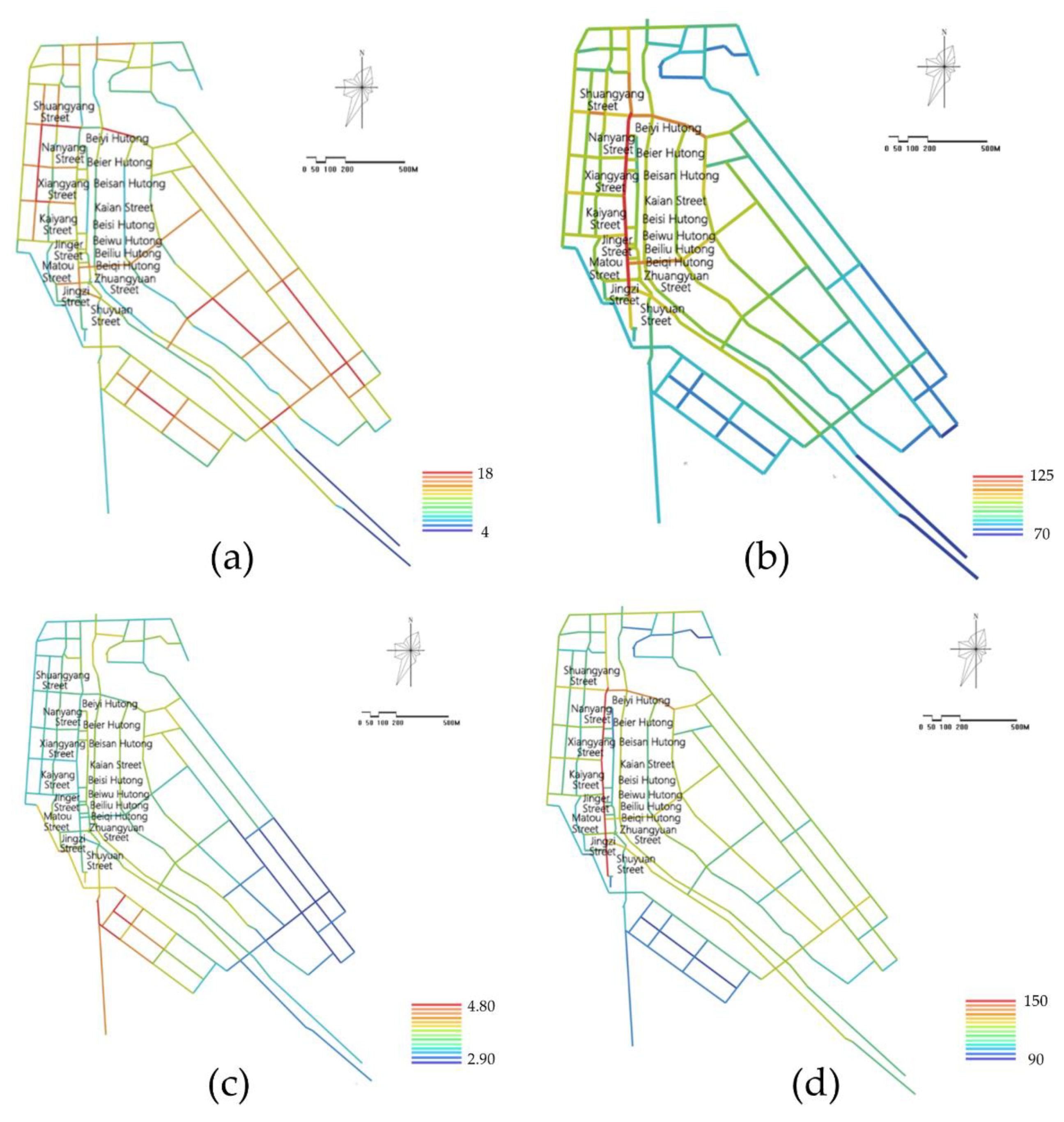
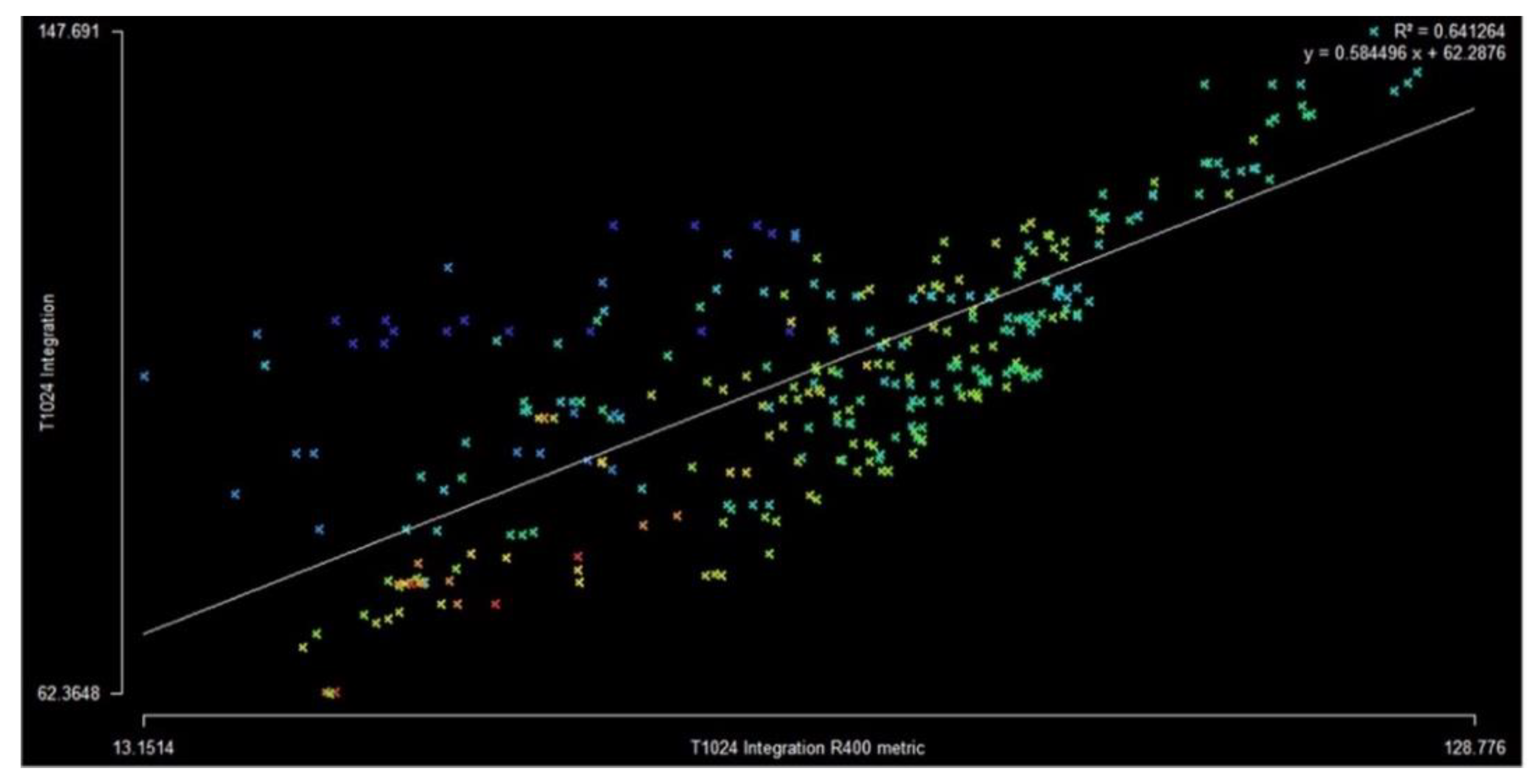
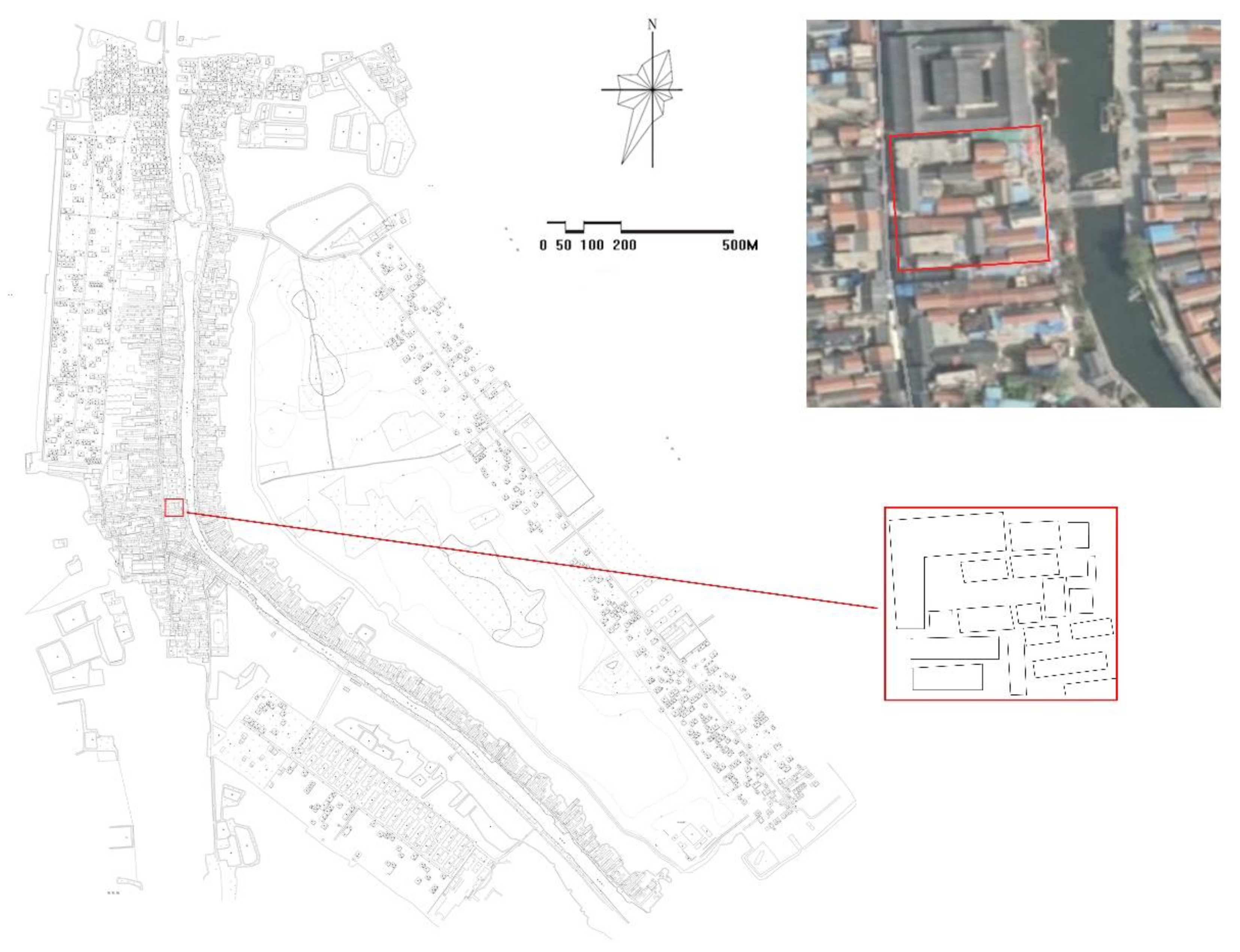
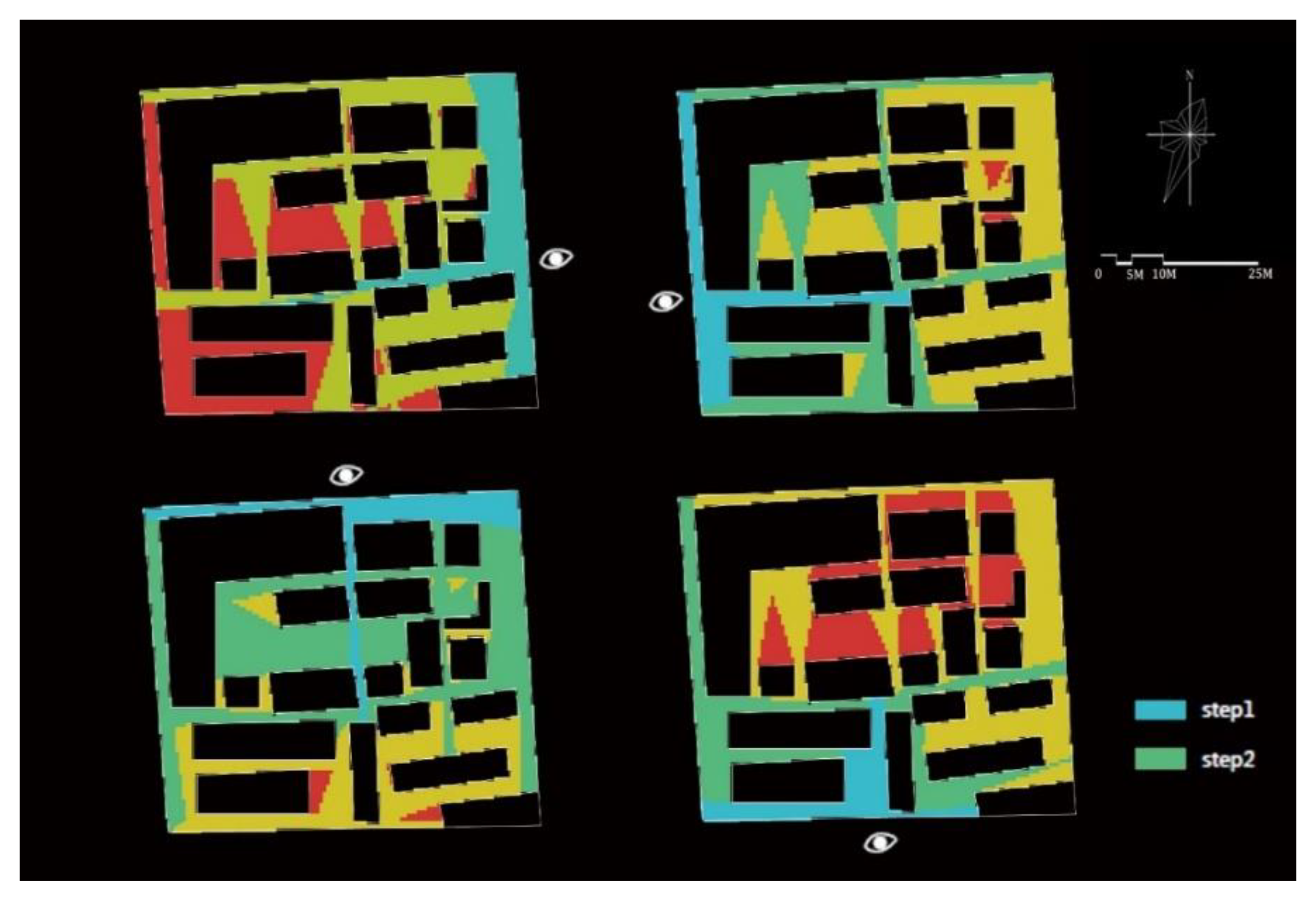
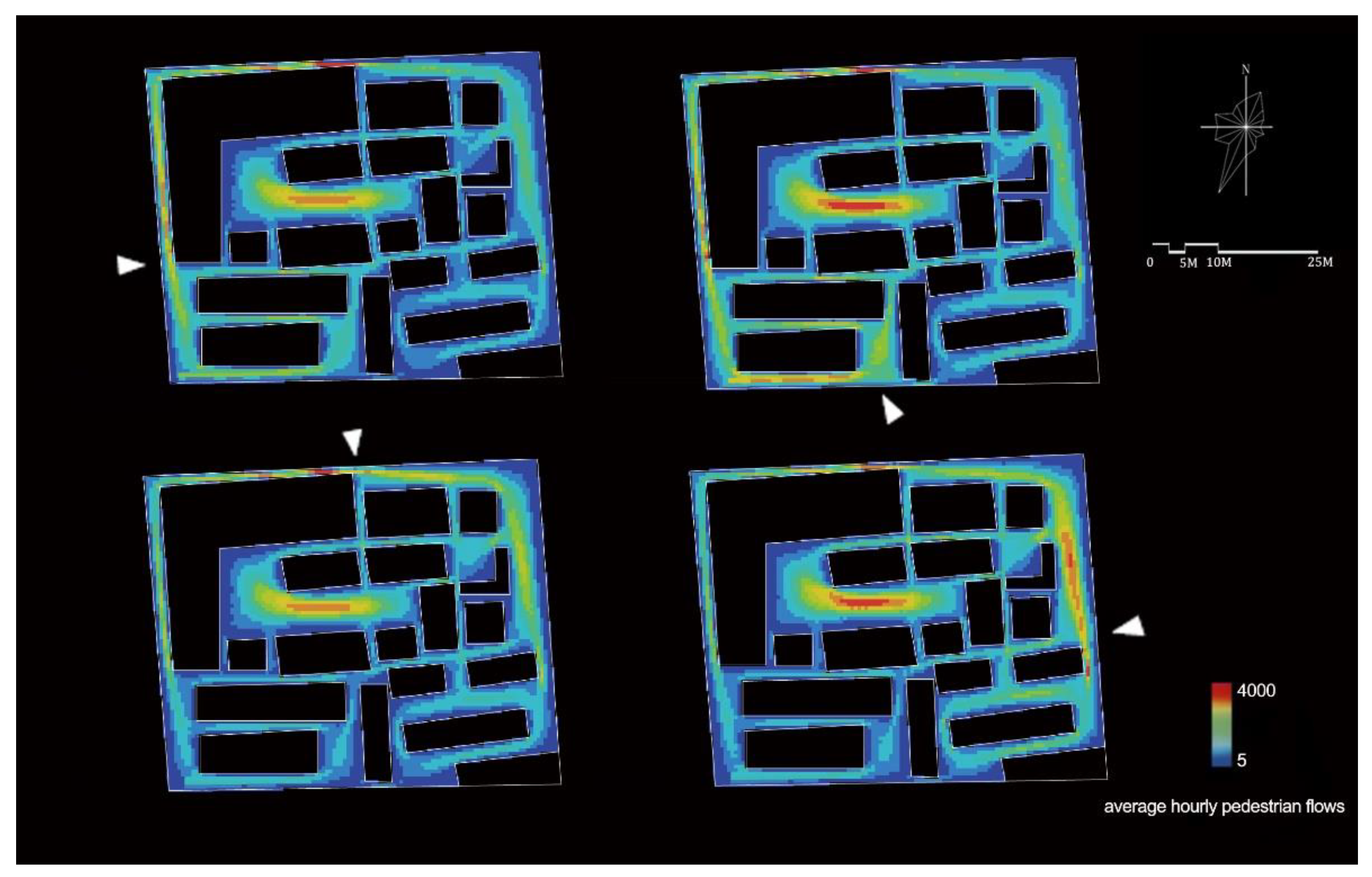
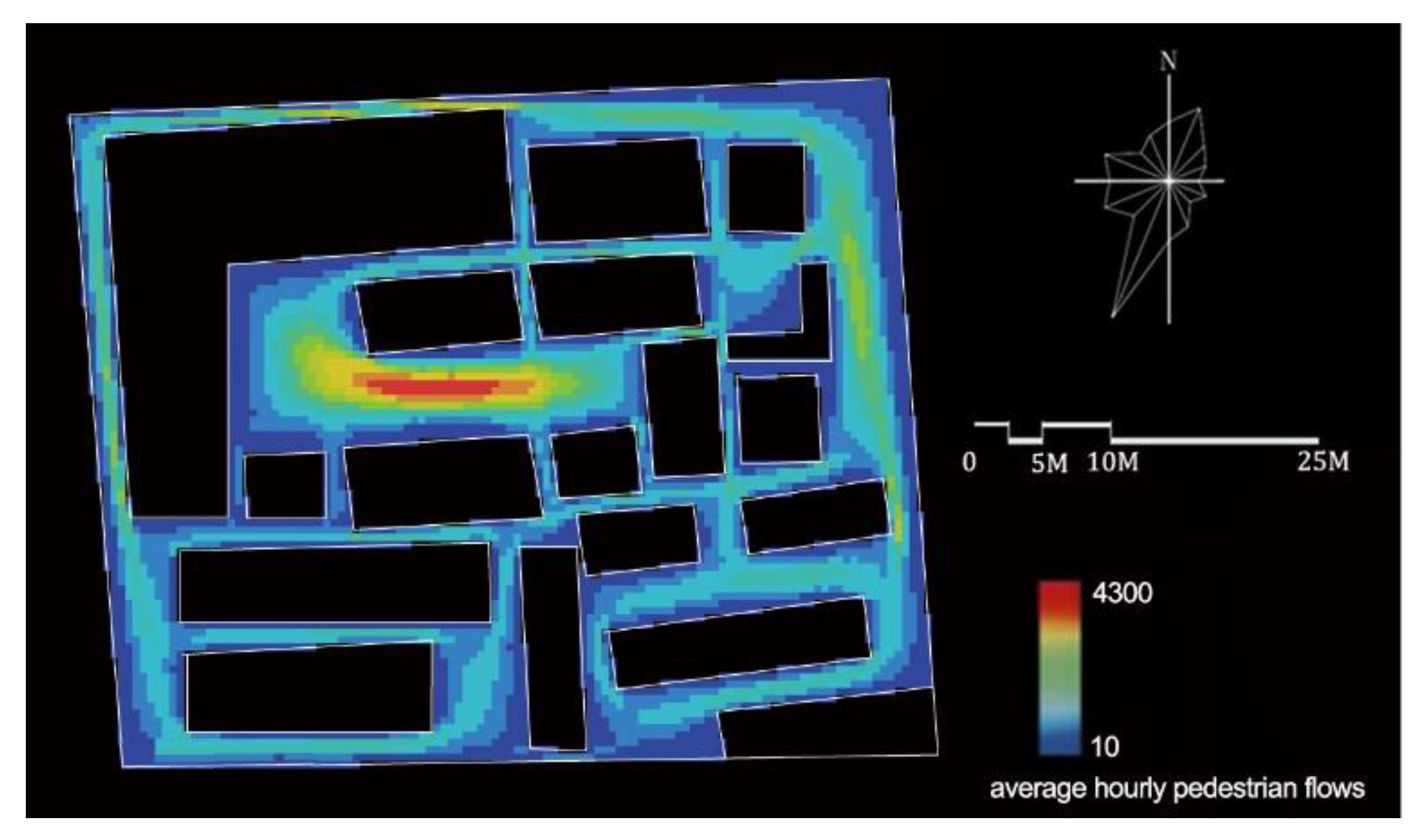
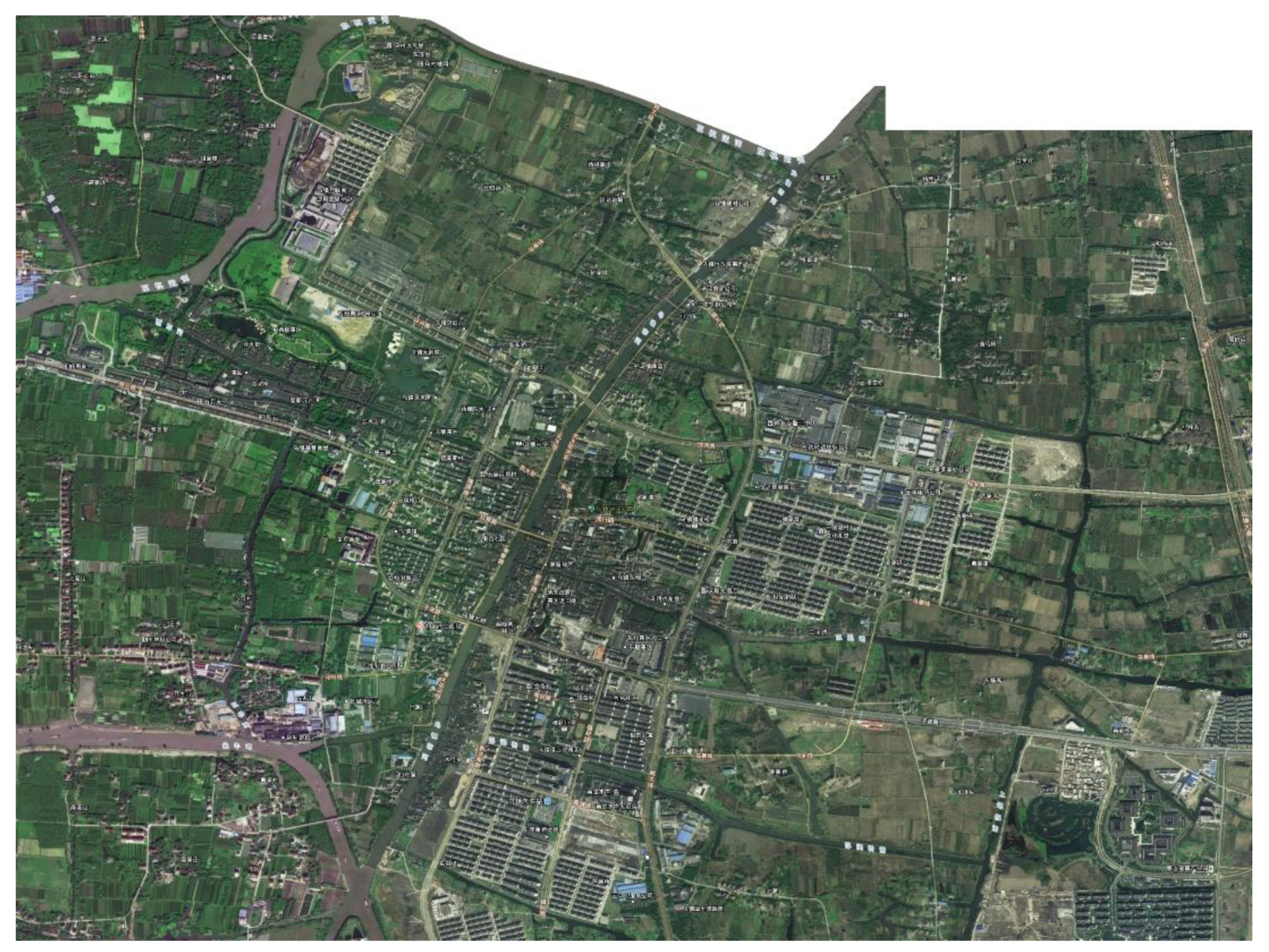
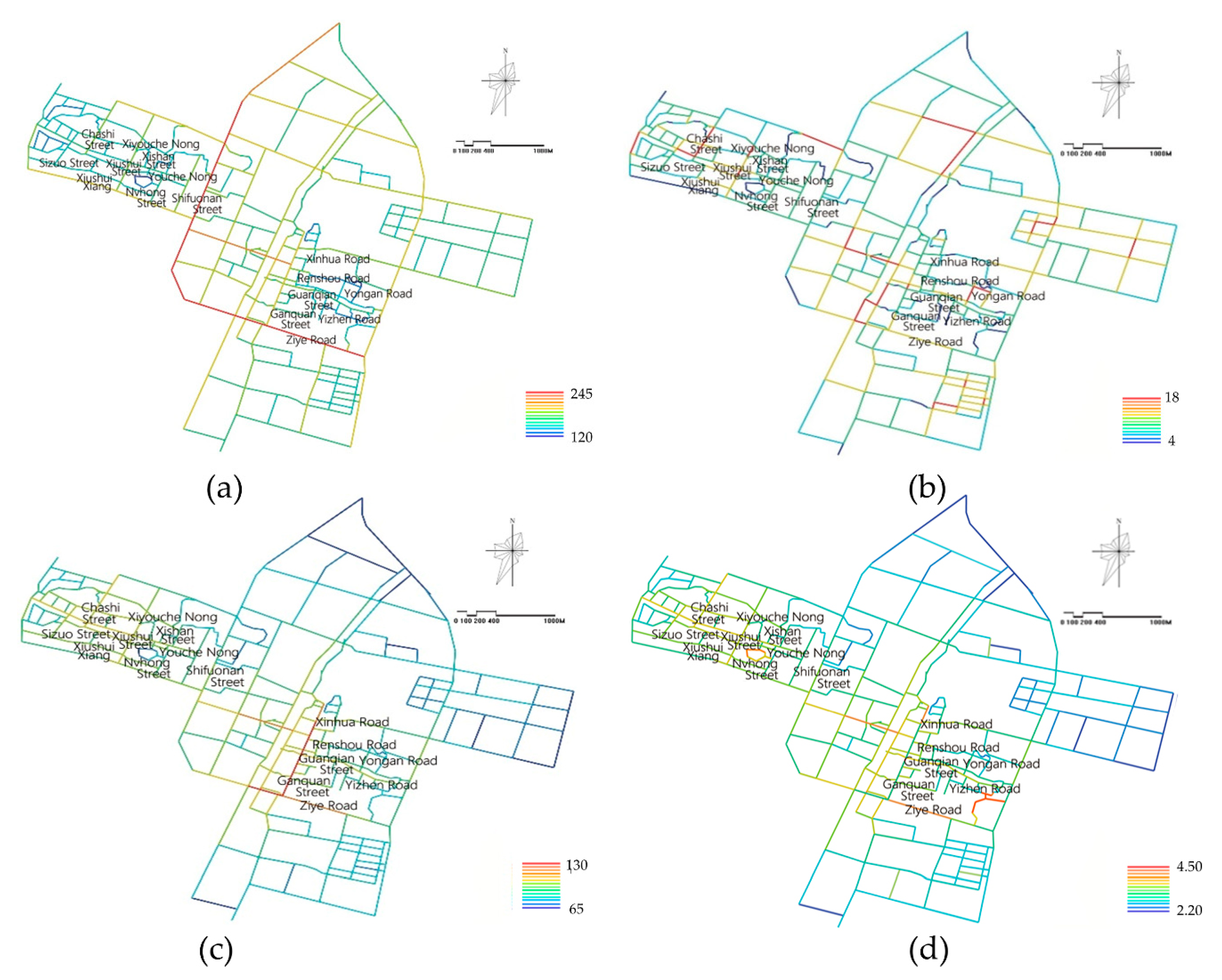
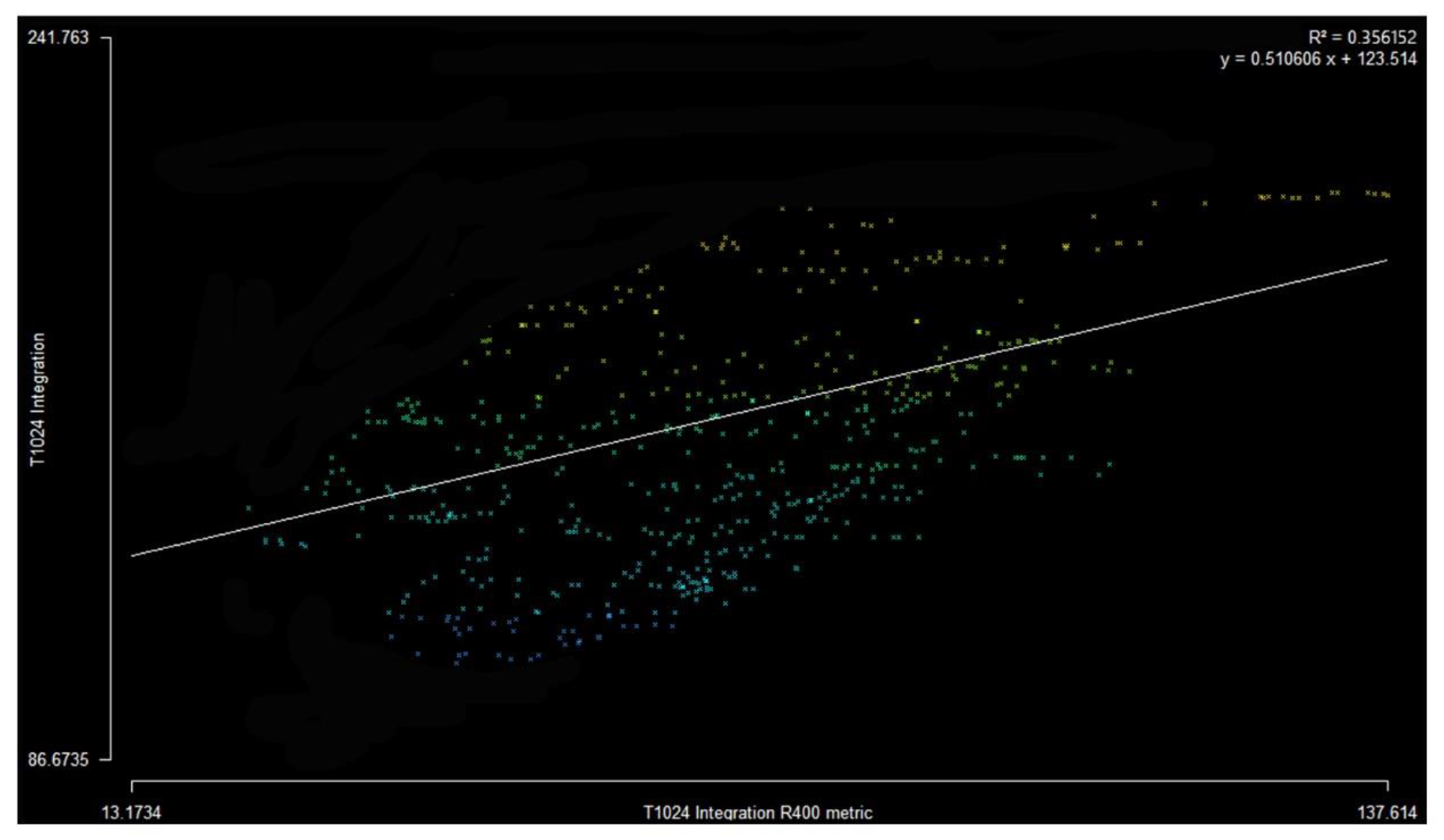
| Analysis Variables in Space Syntax Model | Spatial Characteristics | Tourist Spatial Cognition Indicators |
|---|---|---|
| Connectivity value | Spatial permeability | Road-network structure is complex. |
| Tourists’ journey through the town is intriguing. | ||
| Control value | Spatial connectivity | Few dead-end roads. |
| Lane ways and streets are well interconnected. | ||
| Few repeated-visit happen. | ||
| Mean depth value | Spatial compactness | High spatial compactness, high tour efficiency. |
| Integration value | Spatial accessibility | There is a clear main tour road. |
| Spatial publicity | There is a significant gathering center. | |
| Intelligibility value | Spatial identifiability | Tourist can accurately determine the current location. |
| Tourist can efficiently find their way to the destinations. | ||
| The spatial functional zoning of the block is clear and easy to identify. |
| Date | Negative Comments | Websites |
|---|---|---|
| 17 September 2015 | The buildings on the island are too crowded and it is boring to visit such an ancient town. | https://bbs.syuan.net/4/s1095657/ |
| 20 June 2015 | The ancient buildings along the road are special and have a taste. Now, the town is a bit over-developed. Many characteristic houses have been demolished. I didn’t see any scenery last time because of walls. The characteristic street can be visited in less than half an hour. | https://bbs.syuan.net/4/s1017001/2/ |
| 4 June 2016 | Dragon Boat Festival in Nanyang is usually very lively. Such a spectacular scene must not be missed. However, the scene will be very crowded. Do remember to keep your money and belongings, and protect your kids, otherwise you may be overcrowded and injured. | https://m.tuniu.com/tipnews/106197/?p=27183 |
| 3 October 2018 | The first impression of Nanyang is that this town is still in the initial development stage: the terminal management is not formal, and the tourism facilities cannot satisfy the requirements of tourists. In summary, the tourism development of the ancient town has just begun, and the software and hardware need to be improved. It is pity that there are too many new things and too few old things in the ancient town. | http://www.mafengwo.cn/i/10768070.html |
| 6 June 2019 | Back on the island, there are restaurants and shopping streets everywhere. The similar commercial streets are not advisable and attractive. | http://www.mafengwo.cn/i/14721294.html |
| 2 August 2019 | It was quite messy on the ancient street, and people are busy with selling. | http://www.mafengwo.cn/i/16289208.html |
| Road Name | Connectivity Value | Control Value | Local Integration Value | Mean Depth Value | Global Integration Value |
|---|---|---|---|---|---|
| Shuangyang Street | 6 | 1.708 | 105.609 | 3.887 | 130.595 |
| Xiangyang Street | 5 | 1.726 | 90.139 | 3.961 | 110.069 |
| Kaiyang Street | 5 | 1.726 | 92.667 | 2.931 | 113.985 |
| Nanyang Street | 18 | 10.031 | 124.960 | 3.300 | 111.841 |
| Jinger Street | 4 | 1.250 | 92.715 | 3.681 | 145.869 |
| Matou Street | 4 | 1.250 | 73.930 | 4.743 | 90.519 |
| Jingzi Street | 5 | 1.726 | 91.193 | 3.930 | 111.232 |
| Shuyuan Street | 5 | 1.726 | 100.868 | 3.662 | 126.501 |
| Zhuangyuan Street | 9 | 3.000 | 108.751 | 3.529 | 129.714 |
| Beiyi Hutong | 3 | 0.814 | 84.983 | 4.384 | 100.951 |
| Beier Hutong | 4 | 1.250 | 85.537 | 4.443 | 100.951 |
| Beisan Hutong | 4 | 1.250 | 84.198 | 4.424 | 100.594 |
| Beisi Hutong | 4 | 1.250 | 85.931 | 4.702 | 102.461 |
| Beiwu Hutong | 4 | 1.076 | 86.401 | 4.046 | 102.487 |
| Beiliu Hutong | 4 | 1.076 | 89.110 | 4.054 | 104.060 |
| Beiqi Hutong | 4 | 1.076 | 88.094 | 4.089 | 103.487 |
| Kaian Street | 9 | 2.430 | 76.425 | 4.653 | 90.414 |
| Average value | 5 | 2.015 | 85.236 | 4.505 | 110.059 |
| Area | Road Name | Global Integration Value | Connectivity Value | Control Value | Local Integration Value | Mean Depth Value |
|---|---|---|---|---|---|---|
| West Scenic Area | Sizhou Street | 134.345 | 9 | 2.430 | 88.988 | 2.764 |
| Xiushui Xiang | 123.249 | 4 | 1.250 | 69.489 | 3.556 | |
| Xiushui Street | 148.472 | 7 | 2.025 | 89.761 | 2.962 | |
| Chashi Street | 176.199 | 10 | 3.452 | 101.969 | 2.252 | |
| Xiyouche Nong | 123.165 | 4 | 1.250 | 74.044 | 2.929 | |
| Xishan Street | 149.067 | 15 | 5.176 | 94.549 | 2.430 | |
| Youche Nong | 170.513 | 14 | 4.408 | 95.644 | 2.713 | |
| Nvhong Street | 142.149 | 8 | 2.500 | 77.698 | 3.441 | |
| Shifuonan Street | 236.458 | 11 | 2.615 | 75.662 | 2.301 | |
| East Scenic Area | Xinhua Road | 207.472 | 17 | 5.320 | 128.387 | 3.198 |
| Renshou Road | 142.804 | 6 | 2.000 | 127.479 | 4.009 | |
| Guanqian Street | 158.328 | 12 | 3.590 | 93.760 | 4.402 | |
| Yizhen Road | 132.802 | 5 | 1.726 | 67.411 | 4.413 | |
| Guanquan Road | 161.741 | 3 | 1.000 | 85.993 | 3.943 | |
| Yongan Road | 126.591 | 7 | 2.025 | 67.283 | 4.238 | |
| Ziye Road | 240.210 | 12 | 3.590 | 110.947 | 2.711 | |
| Average value | 160.848 | 9 | 2.750 | 90.567 | 3.266 |
| Nanyang Ancient Town Area | Wuzhen Ancient Town Area | |||
|---|---|---|---|---|
| Similarities | Current situation | Location of Grand Canal in the town | 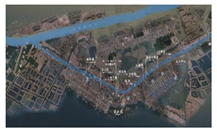 |  |
| Grand Canal runs through the ancient town areas | ||||
| Similar scale | ||||
| Space syntax model analysis results | Connectivity value | The streets which have relatively high value are dispersed in the town. | ||
| Local integration value | The relatively highest value is the main tourist street | |||
| Global integration value | The streets which have relatively highest value are functionally important. | |||
| Mean depth value | Relatively low | |||
| Differences | Current situation | One scenic area located on the west side of the Grand Canal. | Two scenic areas located on the east side and west side of the Grand Canal. | |
| Developing tourist town | Developed tourist town | |||
| Space syntax model analysis results | Connectivity value | Two streets connecting Nanyang Dam have highest value. | Two entrances in West Scenic area have highest value. | |
| Local integration value | Highest value is main tourist street. | The main street in East Scenic area has highest value. | ||
| Global integration value | Highest value is main tourist street. | A vehicle-way running through the East and West Scenic areas has highest value. | ||
| Mean depth value | Relatively low in ancient town area. | The main entrances in East Scenic area have highest value. | ||
| Intelligibility value | 0.641 (strong). | 0.356 (weak). | ||
| Name | Present Situation | Suggestions |
|---|---|---|
| Beiyi Hutong | Dead-end road, two key cultural relics are in the Hutong. | Conservatively rebuild and enhance the conserving the historic buildings. |
| Kaiyang Street | Low spatial compactness. | Strengthen connections between the street and other sites. |
| Beiwu Hutong | Repeat-visit often happens to tourists in this Hutong. | Introducing new and different functions. |
| Matou Street | There is no clear main tour destination and gathering center. | Raising the distinctive level. |
| Kaishan Street | There is no significant gathering center. | A significant gathering center should be built. |
| Heshen Hutong | Tourists hardly visit this Hutong. | Replacing the service function. |
| Songzi Hutong | Nearby Zhuangyuan Bridge, this Hutong has the highest pedestrian flow. | Build a gathering center or increase the number of shops. |
© 2020 by the authors. Licensee MDPI, Basel, Switzerland. This article is an open access article distributed under the terms and conditions of the Creative Commons Attribution (CC BY) license (http://creativecommons.org/licenses/by/4.0/).
Share and Cite
Xu, Y.; Rollo, J.; Jones, D.S.; Esteban, Y.; Tong, H.; Mu, Q. Towards Sustainable Heritage Tourism: A Space Syntax-Based Analysis Method to Improve Tourists’ Spatial Cognition in Chinese Historic Districts. Buildings 2020, 10, 29. https://doi.org/10.3390/buildings10020029
Xu Y, Rollo J, Jones DS, Esteban Y, Tong H, Mu Q. Towards Sustainable Heritage Tourism: A Space Syntax-Based Analysis Method to Improve Tourists’ Spatial Cognition in Chinese Historic Districts. Buildings. 2020; 10(2):29. https://doi.org/10.3390/buildings10020029
Chicago/Turabian StyleXu, Yabing, John Rollo, David S. Jones, Yolanda Esteban, Hui Tong, and Qipeng Mu. 2020. "Towards Sustainable Heritage Tourism: A Space Syntax-Based Analysis Method to Improve Tourists’ Spatial Cognition in Chinese Historic Districts" Buildings 10, no. 2: 29. https://doi.org/10.3390/buildings10020029
APA StyleXu, Y., Rollo, J., Jones, D. S., Esteban, Y., Tong, H., & Mu, Q. (2020). Towards Sustainable Heritage Tourism: A Space Syntax-Based Analysis Method to Improve Tourists’ Spatial Cognition in Chinese Historic Districts. Buildings, 10(2), 29. https://doi.org/10.3390/buildings10020029





